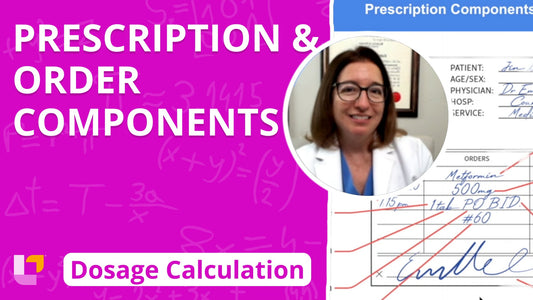Dosage Calculation (36)

Dosage Calc, part 35: Rule of Nines and Parkland Formula
How the Rule of Nines and the Parkland Formula are used to guide fluid resuscitation with severe burns. An example problem that uses both the Rule of Nines and the...
Dosage Calc, part 35: Rule of Nines and Parkland Formula
How the Rule of Nines and the Parkland Formula are used to guide fluid resuscitation with severe burns. An example problem that uses both the Rule of Nines and the...

Dosage Calc, part 34: Body Surface Area
The formula used to calculate a patient’s body surface area (BSA) and a dosage calculation problem based on a patient’s BSA, using multiple methods, including dimensional analysis, ratio & proportion,...
Dosage Calc, part 34: Body Surface Area
The formula used to calculate a patient’s body surface area (BSA) and a dosage calculation problem based on a patient’s BSA, using multiple methods, including dimensional analysis, ratio & proportion,...

Dosage Calc, part 33: Insulin Titration
A dosage calculation problem involving insulin titration and the use of an insulin drip protocol.
Dosage Calc, part 33: Insulin Titration
A dosage calculation problem involving insulin titration and the use of an insulin drip protocol.

Dosage Calc, part 32: Heparin Titration
A dosage calculation problem involving heparin titration, using multiple methods, including dimensional analysis, ratio & proportion, and the formula method.
Dosage Calc, part 32: Heparin Titration
A dosage calculation problem involving heparin titration, using multiple methods, including dimensional analysis, ratio & proportion, and the formula method.

Dosage Calc, part 31: Medication Titration
The concept of medication titration and provide examples of medications that are often titrated. An example problem involving medication titration, using multiple methods, including dimensional analysis, ratio & proportion, and...
Dosage Calc, part 31: Medication Titration
The concept of medication titration and provide examples of medications that are often titrated. An example problem involving medication titration, using multiple methods, including dimensional analysis, ratio & proportion, and...

Dosage Calc, part 30: PCA Pumps
What a patient controlled analgesia (PCA) pump is used for and some of the available settings on a PCA pump. An example problem where you calculate the amount of medication...
Dosage Calc, part 30: PCA Pumps
What a patient controlled analgesia (PCA) pump is used for and some of the available settings on a PCA pump. An example problem where you calculate the amount of medication...

Dosage Calc, part 29: Maternity Nursing - Calculating Blood Loss
How to calculate blood less following the delivery of a baby.
Dosage Calc, part 29: Maternity Nursing - Calculating Blood Loss
How to calculate blood less following the delivery of a baby.

Dosage Calc, part 28: Maternity Magnesium
A dosage calculation problem that involves the administration of magnesium, using multiple methods, including dimensional analysis, ratio & proportion, and the formula method.
Dosage Calc, part 28: Maternity Magnesium
A dosage calculation problem that involves the administration of magnesium, using multiple methods, including dimensional analysis, ratio & proportion, and the formula method.

Dosage Calc, part 27: Maternity Oxytocin
Several dosage calculation problems that involve the administration of oxytocin, using multiple methods, including dimensional analysis, ratio & proportion, and the formula method.
Dosage Calc, part 27: Maternity Oxytocin
Several dosage calculation problems that involve the administration of oxytocin, using multiple methods, including dimensional analysis, ratio & proportion, and the formula method.

Dosage Calc, part 26: Pediatrics - Strength of Feeds
Several dosage calculation problems that involve dilution of formula and strength of feeds.
Dosage Calc, part 26: Pediatrics - Strength of Feeds
Several dosage calculation problems that involve dilution of formula and strength of feeds.

Dosage Calc, part 25: Pediatrics - Calculating Intake & Output
How to calculate a pediatric patient’s 24 hour fluid balance in milliliters.
Dosage Calc, part 25: Pediatrics - Calculating Intake & Output
How to calculate a pediatric patient’s 24 hour fluid balance in milliliters.

Dosage Calc, part 24: Pediatrics - Calculating Maintenance Fluids
How to calculate the amount of maintenance fluids required by a pediatric patient within a 24 hour period. Children and infants are particularly susceptible to diarrhea and dehydration, which in...
Dosage Calc, part 24: Pediatrics - Calculating Maintenance Fluids
How to calculate the amount of maintenance fluids required by a pediatric patient within a 24 hour period. Children and infants are particularly susceptible to diarrhea and dehydration, which in...

Dosage Calc, part 23: Pediatric Safe Dosage Range
A pediatric dosage calculation problem that involves calculating the safe dosage range for a child, using multiple methods, including dimensional analysis, ratio & proportion, and the formula method.
Dosage Calc, part 23: Pediatric Safe Dosage Range
A pediatric dosage calculation problem that involves calculating the safe dosage range for a child, using multiple methods, including dimensional analysis, ratio & proportion, and the formula method.

Dosage Calc, part 22: Pediatric Weight-Based Dosing
A pediatric dosage calculation problem that involves weight-based dosing. Within the pediatric population, this is the common method for determining the appropriate dose for a child. A review of how...
Dosage Calc, part 22: Pediatric Weight-Based Dosing
A pediatric dosage calculation problem that involves weight-based dosing. Within the pediatric population, this is the common method for determining the appropriate dose for a child. A review of how...

Dosage Calc, part 21: Calculating IV Fluid and Medication Intake
A variety of dosage calculation problems that involve calculating a patient’s IV fluid and medication intake over a period of time. These problems includes situations where the infusion rate changes...
Dosage Calc, part 21: Calculating IV Fluid and Medication Intake
A variety of dosage calculation problems that involve calculating a patient’s IV fluid and medication intake over a period of time. These problems includes situations where the infusion rate changes...

Dosage Calc, part 20: Calculating Intake & Output
How to calculate your patient’s 24 hour fluid balance in milliliters. Important information on how to document the volume of fluid from ice chips!
Dosage Calc, part 20: Calculating Intake & Output
How to calculate your patient’s 24 hour fluid balance in milliliters. Important information on how to document the volume of fluid from ice chips!

Dosage Calc, part 19: Weight-Based IV Infusions
A variety of dosage calculation problems that involve weight-based IV infusions, using multiple methods, including dimensional analysis, ratio and proportion, and the formula method.
Dosage Calc, part 19: Weight-Based IV Infusions
A variety of dosage calculation problems that involve weight-based IV infusions, using multiple methods, including dimensional analysis, ratio and proportion, and the formula method.

Dosage Calc, part 18: Delivering IV Fluids Using Gravity
A variety of dosage calculation problems that involve delivering IV fluids using gravity (as opposed to a pump). How flow rate is regulated when using gravity, explains what drop factor...
Dosage Calc, part 18: Delivering IV Fluids Using Gravity
A variety of dosage calculation problems that involve delivering IV fluids using gravity (as opposed to a pump). How flow rate is regulated when using gravity, explains what drop factor...

Dosage Calc, part 17: Delivering IV Fluids Using an IV Pump
A variety of dosage calculation problems that involve IV pumps, using multiple methods, including dimensional analysis, ratio and proportion, and the formula method.
Dosage Calc, part 17: Delivering IV Fluids Using an IV Pump
A variety of dosage calculation problems that involve IV pumps, using multiple methods, including dimensional analysis, ratio and proportion, and the formula method.

Dosage Calc, part 16: Reconstitution and Dilution
A dosage calculation problem that involves BOTH reconstitution and dilution, using three different methods: dimensional analysis, ratio and proportion, and the formula method.
Dosage Calc, part 16: Reconstitution and Dilution
A dosage calculation problem that involves BOTH reconstitution and dilution, using three different methods: dimensional analysis, ratio and proportion, and the formula method.

Dosage Calc, part 15: Dilution
Several dosage calculation problems involving dilution, using three different methods: dimensional analysis, ratio and proportion, and the formula method.
Dosage Calc, part 15: Dilution
Several dosage calculation problems involving dilution, using three different methods: dimensional analysis, ratio and proportion, and the formula method.

Dosage Calc, part 14: Reconstitution
A dosage calculation problem involving reconstitution. The differences between concentration, reconstitution, and dilution so you can fully understand what those terms mean. A reconstitution problem using three different methods: dimensional...
Dosage Calc, part 14: Reconstitution
A dosage calculation problem involving reconstitution. The differences between concentration, reconstitution, and dilution so you can fully understand what those terms mean. A reconstitution problem using three different methods: dimensional...

Dosage Calc, part 13: Insulin - Correctional, Fixed, and/or Nutritional Coverage
A variety of insulin orders, including orders for correctional coverage, orders for fixed AND correctional coverage, orders for nutritional coverage, and orders for nutritional AND correctional coverage.
Dosage Calc, part 13: Insulin - Correctional, Fixed, and/or Nutritional Coverage
A variety of insulin orders, including orders for correctional coverage, orders for fixed AND correctional coverage, orders for nutritional coverage, and orders for nutritional AND correctional coverage.

Dosage Calc, part 12: Insulin Syringes and Mixing Insulins
Key information about insulin syringes. Important points about mixing insulins and an example problem involving mixing insulins.
Dosage Calc, part 12: Insulin Syringes and Mixing Insulins
Key information about insulin syringes. Important points about mixing insulins and an example problem involving mixing insulins.

Dosage Calc, part 11: Injectable Medications
Dosage calculation problems involving injectable medications, using three different methods: dimensional analysis, ratio and proportion, and the formula method.
Dosage Calc, part 11: Injectable Medications
Dosage calculation problems involving injectable medications, using three different methods: dimensional analysis, ratio and proportion, and the formula method.

Dosage Calc, part 10: Oral Medications - Liquid Medications
Several dosage calculation problems involving oral medications, specifically liquid medications, using three different methods: dimensional analysis, ratio & proportion, and the formula method.
Dosage Calc, part 10: Oral Medications - Liquid Medications
Several dosage calculation problems involving oral medications, specifically liquid medications, using three different methods: dimensional analysis, ratio & proportion, and the formula method.

Dosage Calc, part 9: Oral Medications - Tablets & Capsules
Dosage calculation problems involving oral medications, specifically an order for tablets or capsules, using three different methods: dimensional analysis, ratio & proportion, and the formula method.
Dosage Calc, part 9: Oral Medications - Tablets & Capsules
Dosage calculation problems involving oral medications, specifically an order for tablets or capsules, using three different methods: dimensional analysis, ratio & proportion, and the formula method.

Dosage Calc, part 8: Drug Label Components
The key components on a drug label. Knowing where to find these components is important for many drug calculation problems!
Dosage Calc, part 8: Drug Label Components
The key components on a drug label. Knowing where to find these components is important for many drug calculation problems!

Dosage Calc, part 7: Prescription and Order Components
The key components of a prescription, the difference between a prescription and a prescription order, and key components of an order. Some examples of prescription orders and the different components...
Dosage Calc, part 7: Prescription and Order Components
The key components of a prescription, the difference between a prescription and a prescription order, and key components of an order. Some examples of prescription orders and the different components...

Dosage Calc, part 6: Converting Between Military and Standard Time
Why military time is used in the hospital setting. How to convert from military time to standard time, and how to convert from standard time to military time.
Dosage Calc, part 6: Converting Between Military and Standard Time
Why military time is used in the hospital setting. How to convert from military time to standard time, and how to convert from standard time to military time.

Dosage Calc, part 5: Temperature Conversion - Converting between Fahrenheit & Celsius
How to convert temperatures. The formula for converting from fahrenheit to celsius, and from celsius to fahrenheit. A couple temperature conversion problems.
Dosage Calc, part 5: Temperature Conversion - Converting between Fahrenheit & Celsius
How to convert temperatures. The formula for converting from fahrenheit to celsius, and from celsius to fahrenheit. A couple temperature conversion problems.

Dosage Calc, part 4: Units of Measure - Converting Between Metric & Household
Several examples of converting units of measure between the metric system and household system using 2 different methods: dimensional analysis and ratio & proportion.
Dosage Calc, part 4: Units of Measure - Converting Between Metric & Household
Several examples of converting units of measure between the metric system and household system using 2 different methods: dimensional analysis and ratio & proportion.

Dosage Calc, part 3: Units of Measure - Converting within Household
Examples of converting units of measure within the household system. Each problem using both dimensional analysis and ratio and proportion.
Dosage Calc, part 3: Units of Measure - Converting within Household
Examples of converting units of measure within the household system. Each problem using both dimensional analysis and ratio and proportion.

Dosage Calc, part 2: Units of Measure - Converting within Metric
The most common metric system prefixes that you will encounter with dosage calculation problems. Examples of converting within the metric system using 3 different methods: dimensional analysis, ratio and proportion,...
Dosage Calc, part 2: Units of Measure - Converting within Metric
The most common metric system prefixes that you will encounter with dosage calculation problems. Examples of converting within the metric system using 3 different methods: dimensional analysis, ratio and proportion,...

Dosage Calc, part 1: Overview of Methods & Key Points
An overview of the three methods used to solve dosage calculation problems, including: dimensional analysis, ratio and proportion, and the formula method. Key points regarding units of measure, the importance...
Dosage Calc, part 1: Overview of Methods & Key Points
An overview of the three methods used to solve dosage calculation problems, including: dimensional analysis, ratio and proportion, and the formula method. Key points regarding units of measure, the importance...

Dosage Calculation: Reconstitution
In this video, Cathy works through a reconstitution dosage calculation problem submitted by a YouTube viewer. She uses dimensional analysis to solve the problem, and goes through each step in...
Dosage Calculation: Reconstitution
In this video, Cathy works through a reconstitution dosage calculation problem submitted by a YouTube viewer. She uses dimensional analysis to solve the problem, and goes through each step in...
Filter Dosage Calculation Articles
Shop
Dosage Calculation - Workbook & Digital Companion
4.811594202 / 5.0
(69) 69 total reviews
Regular price $49.95Regular priceUnit price / per$49.95Sale price $49.95Videos by Subject
Tips & More
Exam Information
Subscribe


